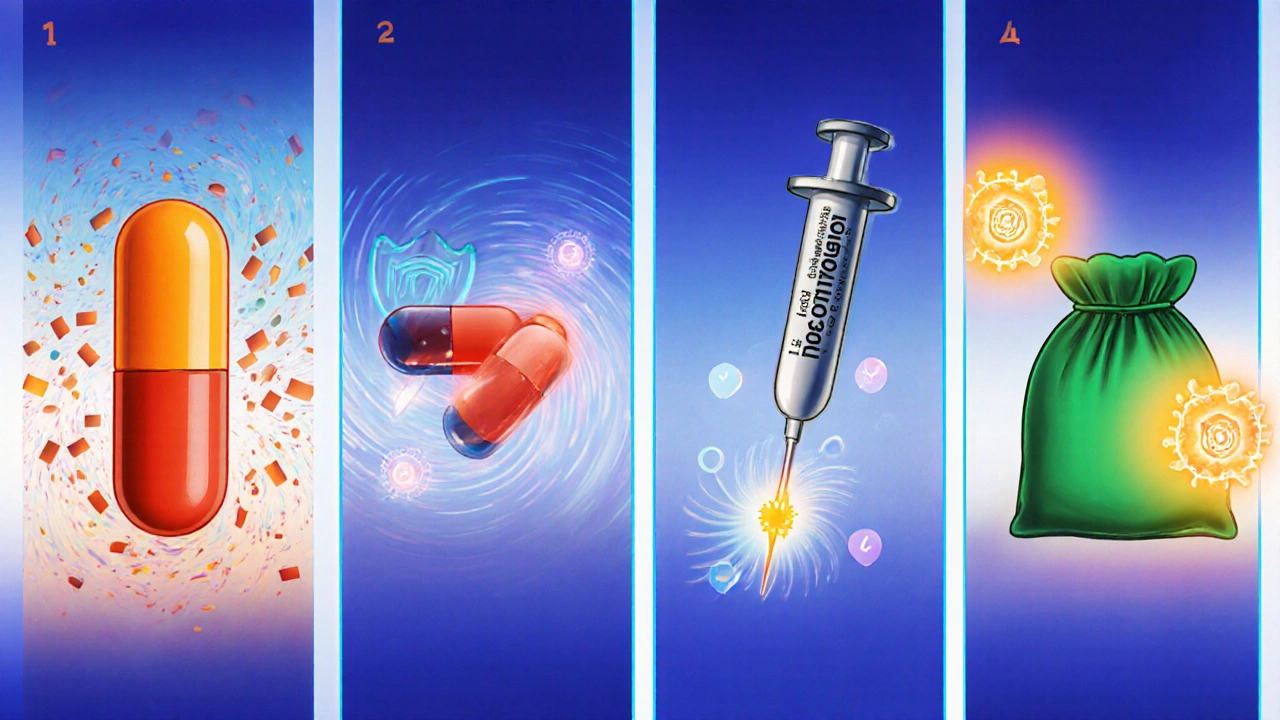Tricor (Fenofibrate) vs Other Lipid‑Lowering Options
 Oct, 5 2025
Oct, 5 2025
Tricor (Fenofibrate) Decision Guide
Enter your values and click "Determine Best Option" to see recommendations.
How This Tool Works
This decision tool evaluates key factors such as triglyceride levels, LDL cholesterol, cardiovascular risk, and medication history to suggest whether Tricor (fenofibrate) is suitable or if another lipid-lowering agent might be better.
Key Recommendations
- Tricor is most effective for high triglycerides and mixed dyslipidemia.
- Statins remain first-line for LDL cholesterol reduction.
- Ezetimibe and PCSK9 inhibitors are useful when statins alone don't reach target LDL levels.
- Prescription omega-3 rivals fenofibrate on triglyceride lowering with a better safety profile.
Key Takeaways
- Tricor (fenofibrate) is most effective for high triglycerides and mixed dyslipidemia.
- Statins remain first‑line for LDL‑cholesterol reduction; they complement or outperform fenofibrate on heart‑attack risk.
- Ezetimibe and PCSK9 inhibitors are useful when statins alone don’t hit target LDL levels.
- Prescription omega‑3 (icosapent ethyl) rivals fenofibrate on triglyceride lowering with a better safety profile.
- Cost, liver function, kidney health, and drug interactions decide which agent fits you best.
When doctors talk about "lipid‑lowering therapy" they usually start with statins. But many patients still struggle with high triglycerides (TG) even after a statin is on board. That’s where Tricor is a brand‑name medication that contains fenofibrate, a fibric acid derivative designed to lower triglycerides and raise HDL‑cholesterol enters the conversation. If you’re wondering whether Tricor is the right move or if another pill might do a better job, this guide lines up the most common alternatives, breaks down how each works, and gives you a cheat‑sheet to pick the best fit.
What Is Tricor (Fenofibrate)?
Fenofibrate belongs to the fibrate class. It activates the peroxisome proliferator‑activated receptor‑α (PPAR‑α), which tells the liver to burn more fatty acids and produce fewer very‑low‑density lipoprotein (VLDL) particles. In plain terms, the drug cuts the amount of triglyceride‑rich lipoproteins circulating in blood and lifts the “good” HDL‑C a bit.
Typical adult dosing in the United States is 145 mg (one 160‑mg tablet after accounting for the coating) taken once daily with a meal. In New Zealand and Australia, the standard is 200mg once daily. The drug is cleared mostly by the kidneys, so dose adjustment is needed for severe renal impairment.
When Does Tricor Make Sense?
- Fasting triglycerides≥200mg/dL (≥2.3mmol/L) despite lifestyle changes.
- Mixed dyslipidemia (high TG+low HDL‑C) that puts a patient at elevated cardiovascular risk.
- Statin‑intolerant patients who need an extra lipid‑lowering tool.
- Patients with hypercholesterolemia secondary to diabetes, metabolic syndrome, or genetic hypertriglyceridemia.
Guidelines from the American Heart Association (2023) and European Society of Cardiology (2024) recommend fibrates mainly for TG>500mg/dL to prevent pancreatitis, and as an add‑on for TG200‑500mg/dL when cardiovascular risk remains high.

Top Alternatives to Tricor
Below is a quick look at the most frequently prescribed lipid‑lowering agents that compete with fenofibrate for the same patient groups.
| Drug | Class | Typical TG Reduction | LDL Effect | Common Side Effects | Usual Dose | Approx. US$/month |
|---|---|---|---|---|---|---|
| Tricor fenofibrate, a fibrate | Fibrate | 30‑50% | ↓5‑10% | GI upset, elevated liver enzymes, muscle pain (rare) | 145mg once daily | ~$30 |
| Atorvastatin synthetic HMG‑CoA reductase inhibitor | Statin | ↓5‑15% | ↓30‑50% | Myopathy, liver enzyme rise, diabetes risk | 10‑80mg daily | ~$10‑$25 |
| Rosuvastatin potent statin | Statin | ↓5‑10% | ↓45‑55% | Muscle aches, liver changes, rare rhabdomyolysis | 5‑40mg daily | ~$12‑$30 |
| Ezetimibe cholesterol absorption inhibitor | Absorption inhibitor | ↓5‑10% | ↓15‑20% | Diarrhea, abdominal pain | 10mg daily | ~$45 |
| Alirocumab PCSK9 monoclonal antibody | PCSK9 inhibitor | ↓10‑15% | ↓60‑70% | Injection site reactions, flu‑like symptoms | 75mg subcutaneous every 2weeks | ~$1,200 |
| Icosapent ethyl prescription omega‑3 fatty acid | Omega‑3 (EPA‑only) | ↓25‑30% | ↓5‑10% | Fishy aftertaste, easy bruising | 2g twice daily | ~$350 |
| Niacin nicotinic acid, vitamin B3 | Vitamin derivative | ↓20‑35% | ↑LDL modestly | Flushing, hyperglycemia, liver toxicity | 500‑2,000mg daily | ~$15 |
| Cholestyramine bile‑acid sequestrant | Resin | ↓10‑15% | ↓15‑20% | Constipation, GI distress, drug interactions | 4g daily | ~$8 |
How Each Option Works
Statins (atorvastatin, rosuvastatin) block HMG‑CoA reductase, the enzyme that makes cholesterol in the liver. The result is a sharp drop in LDL‑C and a modest dip in TG. Because LDL‑C is the strongest predictor of heart attacks, guidelines keep statins as first‑line.
Ezetimibe stops the absorption of cholesterol from the intestine. It adds about a 15‑20% LDL‑C reduction when paired with a statin, but its effect on TG is limited.
PCSK9 inhibitors (alirocumab, evolocumab) are antibodies that keep LDL receptors on liver cells from being destroyed, so the liver pulls more LDL‑C out of the blood. They achieve up to a 70% LDL‑C drop, useful for patients with familial hypercholesterolemia or statin intolerance.
Prescription omega‑3 (icosapent ethyl) provides high‑dose EPA, which competes with fatty acids for incorporation into VLDL particles, producing a notable TG fall without raising LDL‑C.
Niacin slows hepatic VLDL secretion and raises HDL‑C, but the flushing side effect and uncertain cardiovascular benefit keep it out of modern guidelines.
Cholestyramine binds bile acids in the gut, forcing the liver to use more cholesterol to make new bile, thus lowering LDL‑C. It can lower TG a bit, but the gritty texture and drug‑binding profile make adherence tough.
Decision‑Making Framework
When you sit down with a clinician, the following factors usually guide the choice:
- Primary lipid abnormality. Is TG the main problem, or is LDL‑C the dominant risk driver?
- Cardiovascular risk level. High‑risk patients (e.g., recent MI, diabetes with organ damage) benefit most from aggressive LDL‑C lowering.
- Drug tolerance. History of statin‑related muscle pain, liver issues, or kidney disease steers the selection.
- Cost and insurance coverage. PCSK9 inhibitors can be life‑saving but are pricey; generics like fenofibrate and statins are far cheaper.
- Drug‑drug interactions. Fenofibrate and statins together raise the rare risk of rhabdomyolysis, especially with high‑dose simvastatin.
- Patient preference. Oral daily pills vs. bi‑weekly injections, need for lifestyle simplicity, and concerns about side‑effects all matter.
Plug your answers into the matrix below to see where Tricor lands.

Putting Tricor Into Context
If your lab shows TG=350mg/dL, LDL‑C=110mg/dL, and you’re already on a moderate‑intensity statin, adding Tricor can shave 30‑40% off that TG number within 8‑12 weeks. For many, that moves the TG level below the 200mg/dL threshold linked to pancreatitis risk.
However, if your LDL‑C is still above target (≥100mg/dL for moderate risk) after the statin, the next step is usually either upping the statin dose or adding ezetimibe/PCSK9 inhibitor. Tricor won’t give you the big LDL‑C drop you need to cut heart‑attack risk.
Patients with chronic kidney disease (eGFR<30mL/min) should avoid fenofibrate unless the benefit clearly outweighs the renal safety concern. In that scenario, an omega‑3 prescription or low‑dose statin may be safer.
Practical Tips & Common Pitfalls
- Take Tricor with a main meal; food boosts absorption and reduces stomach upset.
- Monitor liver enzymes (ALT/AST) at baseline and after 6‑12 weeks of therapy. If they rise >3× upper limit, consider dose reduction or switch.
- When combining a fibrate with a statin, prefer rosuvastatin or pravastatin at low dose to keep rhabdomyolysis risk low.
- Patients on anticoagulants (warfarin) may need INR checks after starting fenofibrate, as it can alter vitaminK metabolism.
- For women of child‑bearing age, avoid fenofibrate during pregnancy; it’s classified as Category X.
Bottom Line
Tricor shines when triglycerides are the primary culprit and the patient can tolerate an oral fibrate. It’s cheap, generally safe, and works fast. But for LDL‑C‑driven risk, statins, ezetimibe, or PCSK9 inhibitors deliver far stronger heart‑protective benefits. Combining therapies can be powerful, yet you must balance efficacy, safety, and cost.
Frequently Asked Questions
Can I take Tricor together with a statin?
Yes, but choose a low‑to‑moderate potency statin (e.g., rosuvastatin 5‑10mg) and watch for muscle pain or elevated CK levels. Your doctor should check liver enzymes and kidney function regularly.
How quickly does Tricor lower triglycerides?
Most patients see a 30‑40% drop within 8‑12 weeks if they stick to the dose and keep a low‑fat diet. Maximum effect may take up to 6 months.
Is fenofibrate safe for people with diabetes?
Generally yes. Fenofibrate does not raise blood glucose and can even improve insulin sensitivity in some studies. Still, monitor A1C after starting therapy, especially if you’re on other glucose‑affecting meds.
What are the main side effects to watch for?
Common issues are mild stomach upset, occasional headache, and a small rise in liver enzymes. Rarely, muscle pain or severe liver injury can occur, prompting a doctor visit.
When should I consider switching from Tricor to another drug?
If triglycerides stay above 500mg/dL after 3 months, if you develop liver or kidney problems, or if you need a stronger LDL‑C reduction for cardiovascular risk, discuss alternatives like high‑dose omega‑3, ezetimibe, or a PCSK9 inhibitor with your clinician.
Erica Ardali
October 5, 2025 AT 18:44Reading the Tricor guide feels like stepping into a maze of lipid lore, where every triglyceride value is a minotaur and every statin a weary hero. The prose drips with the gravitas of a pharmacological treatise, yet somehow manages to keep the heart of the matter in plain sight. If you’re looking for a cure‑all, you’ll be disappointed, but if you crave nuance, you’ve found a rare gem.
Justyne Walsh
October 12, 2025 AT 19:59Ah, the magnificent price‑tag of fenofibrate – the perfect illustration of how healthcare can turn a simple pill into a regal tribute to corporate profit. One would think that if the drug truly deserved its throne, it would at least command respect without the constant need for a statin sidekick. But alas, the market loves to remind us who holds the purse strings.
Mimi Saki
October 19, 2025 AT 21:15Thanks for the clear breakdown! 😊
Subramaniam Sankaranarayanan
October 26, 2025 AT 22:31First, let’s demystify the pharmacodynamics: fenofibrate activates PPAR‑α, which upregulates lipoprotein lipase, thereby accelerating the catabolism of triglyceride‑rich VLDL particles. This mechanism is particularly effective when TG levels exceed 200 mg/dL, as the drug can achieve a 30‑50% reduction within three months. However, the LDL‑C lowering effect is modest, typically a 5‑10% drop, which pales in comparison to the 30‑50% reductions seen with statins. Moreover, the interaction risk with high‑dose statins, especially simvastatin, cannot be ignored due to the potential for rhabdomyolysis. In patients with mild to moderate renal impairment (eGFR > 30 mL/min), dose adjustment is advisable, but fenofibrate remains generally safe. Finally, cost considerations are non‑trivial; generic fenofibrate hovers around $30 per month, a stark contrast to PCSK9 inhibitors that can exceed $1,200 monthly. In sum, fenofibrate shines in triglyceride‑dominant dyslipidemia, but for LDL‑driven risk, statins or PCSK9 inhibitors remain the gold standard.
Kylie Holmes
November 2, 2025 AT 23:47Yo, if your TGs are sky‑high, throw Tricor in the mix and watch those numbers tumble! Just remember to keep the diet clean and stay on top of your labs.
Jennifer Wees-Schkade
November 10, 2025 AT 01:02Here’s a practical approach: start by confirming the triglyceride threshold. If TG ≥ 200 mg/dL and LDL‑C is already at goal, fenofibrate is a reasonable add‑on, especially when statin tolerance is an issue. Monitor liver enzymes and creatinine at baseline, then after 6‑8 weeks. Watch for signs of myopathy if you’re on a statin, preferring low‑to‑moderate potency statins like rosuvastatin 5 mg. Finally, reassess lipid panel after 12 weeks to gauge efficacy and decide on continuation.
Fr. Chuck Bradley
November 17, 2025 AT 02:18Oh, the drama of choosing between a pill that whispers promises and another that shouts results! In the grand theater of lipid management, Tricor often plays the understudy – ready to step in when the lead statin falters. Yet the curtain never truly falls without a careful script of labs and patient stories.